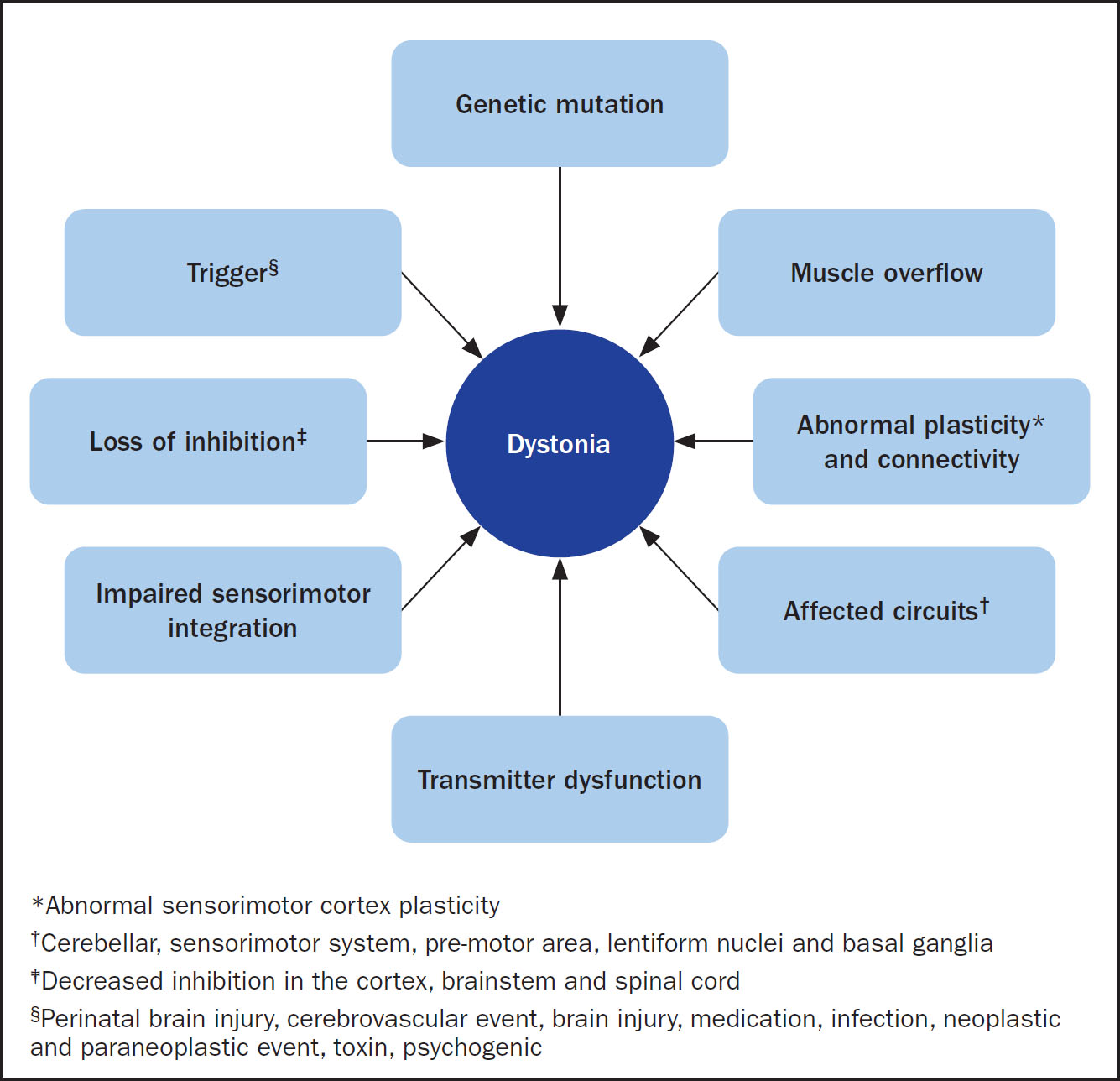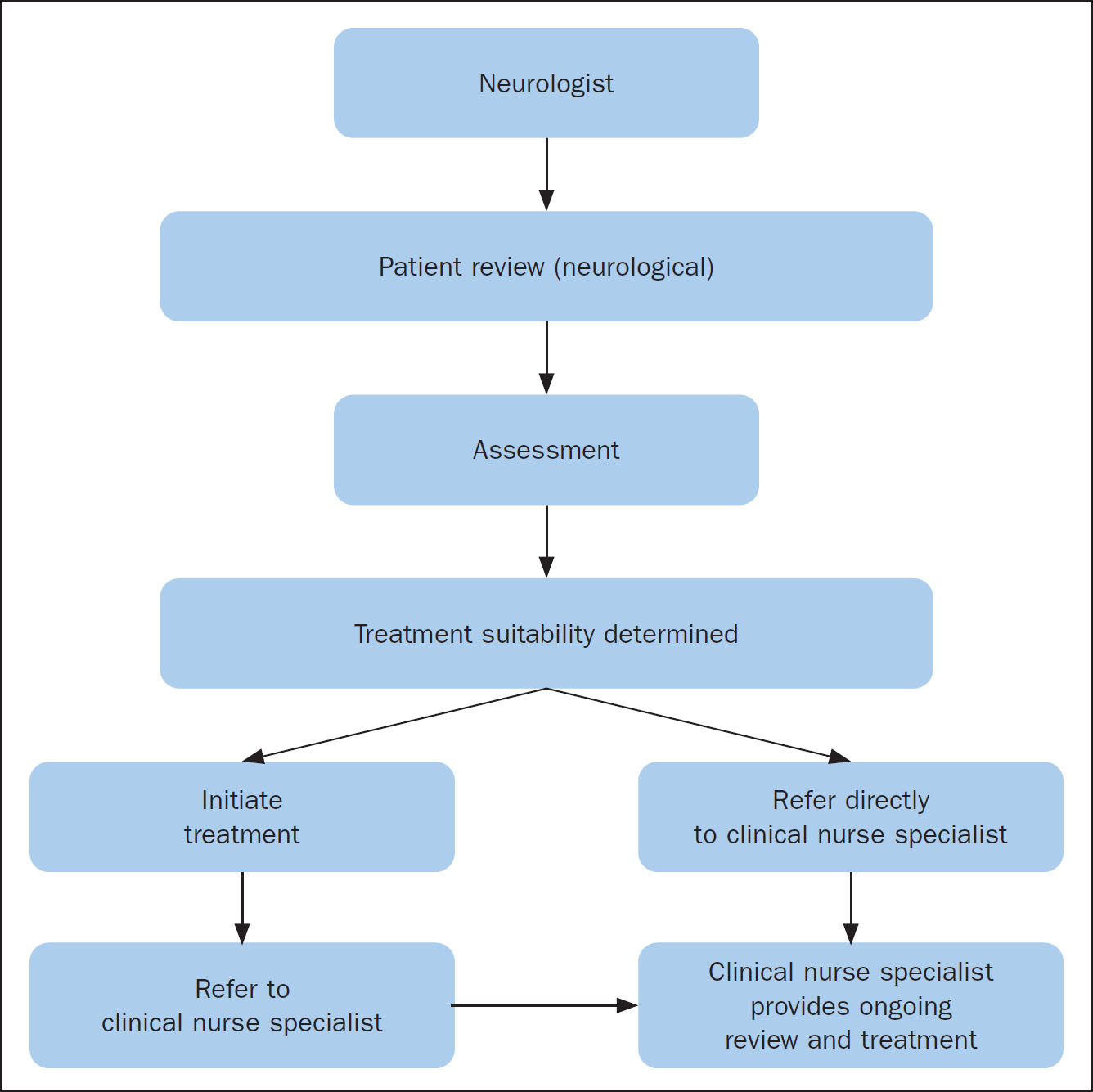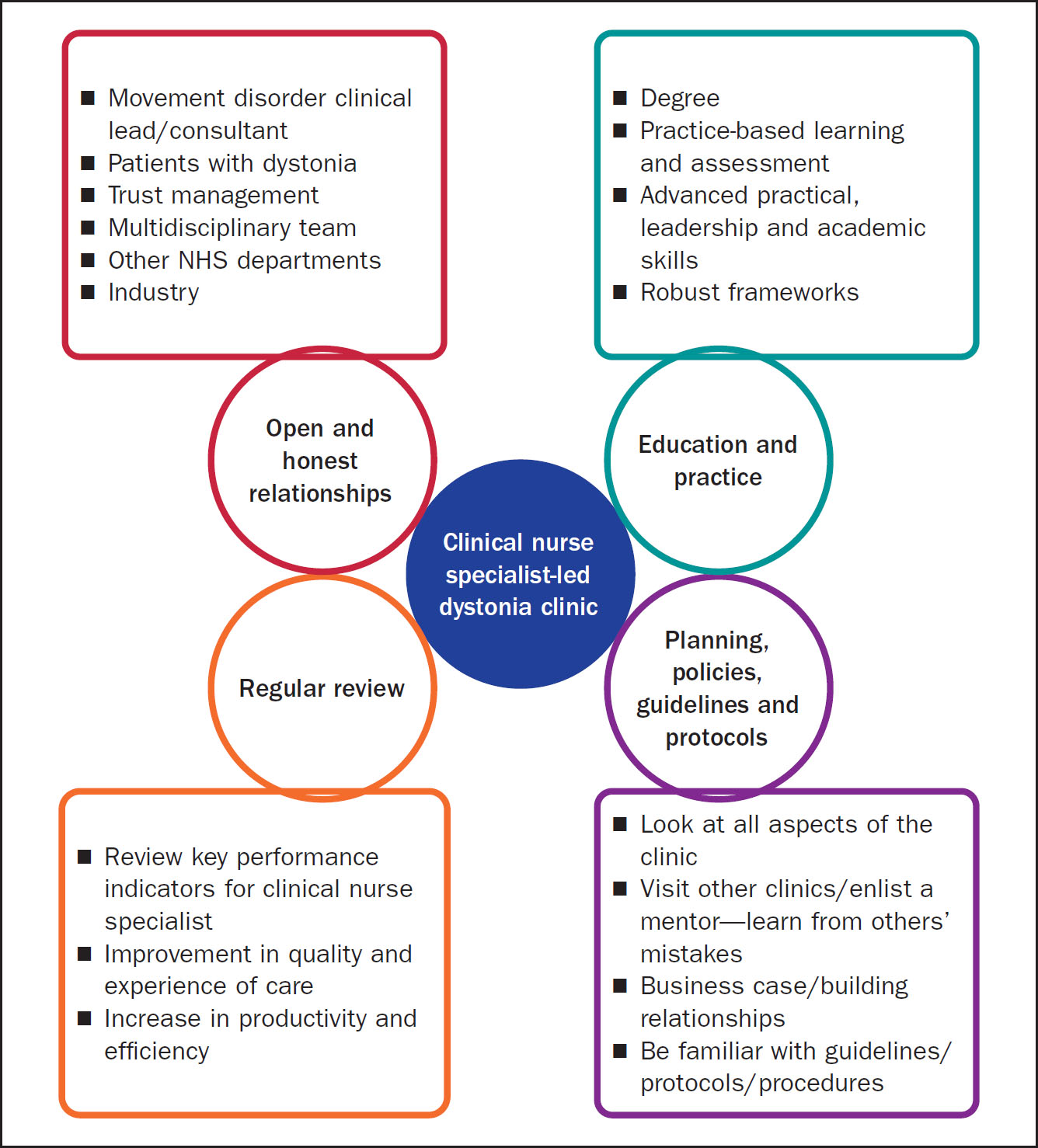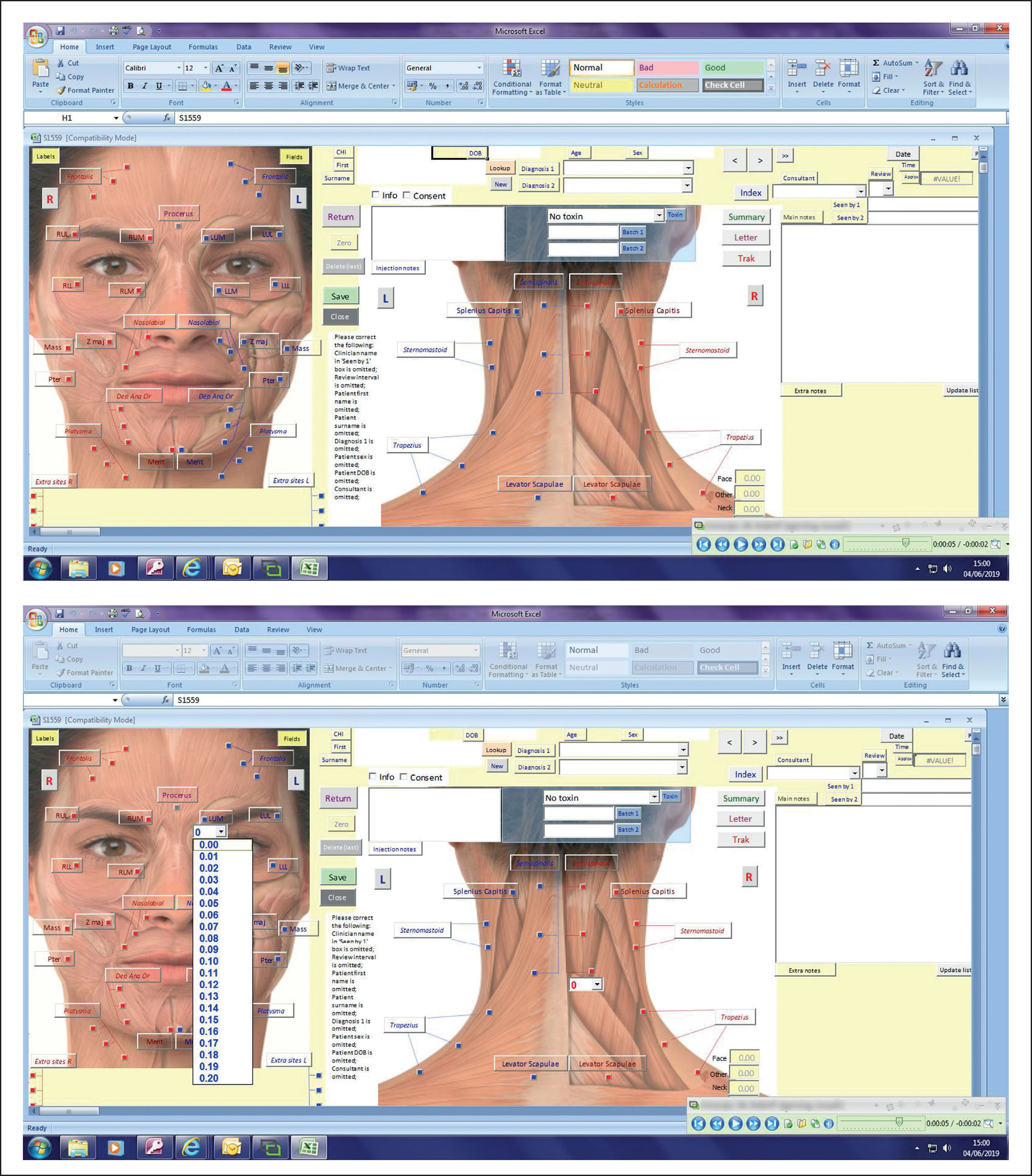Dystonia is a movement disorder characterised by sustained or intermittent muscle contractions causing abnormal, often repetitive, movements, postures, or both. It is frequently initiated or worsened by voluntary action and associated with overflow muscle activation. The dystonic movements are typically patterned, twisting, and may be tremulous (Albanese et al, 2013). The severity of dystonia can change, depending on activity and posture (Blood, 2008; Beena, 2017). Although the pathophysiology of dystonia is currently not completely understood, recent research to identify dystonia genes and advances in functional neuroimaging have led to important insights into the mechanisms of the condition (Sharma, 2019; Gonzalez-Alegre, 2019). Conceptually, dystonia is a neurofunctional disorder with multiple causes for the alterations at various levels and multiple points along the sensorimotor circuit (see Figure 1) (Lubarr and Bressman, 2011). There is evidence that the pathophysiology of dystonia may involve a combination of dysfunction within neurons of the brainstem, cerebellum, putamen, and globus pallidus (Sharma, 2019). Furthermore, genetic research over the past two decades has identified that DYT1 is the most common early-onset inherited dystonia, caused by dominant disease-causing mutations in the TOR1A gene. TorsinA, a glycoprotein encoded by the TOR1A gene in the endoplasmic reticulum and nuclear envelope, influences various important cellular functions (Gonzalez-Alegre, 2019).

The diagnosis of dystonia can be clinically challenging due to the heterogeneous presentation. Essential tremor is a common neurological disorder, that may be mimicked by other movement disorders, and often leads to misdiagnosis (Kim and Louis, 2018). The diagnosis of dystonia is largely based on clinical features, with expert observation by a movement disorder specialist, although diagnostic laboratory testing can provide supportive evidence (Logroscino et al, 2003; Albanese et al, 2006). A structured clinical approach guides dystonia assessment and treatment (Castagna and Albanese, 2019).
Classification
The classification system for dystonia (see Table 1), is based on clinical characteristics (age at onset, body distribution, temporal pattern, the coexistence of other movement disorders and associated neurologic features), and aetiology (nervous system pathology and inheritance) (Albanese et al, 2013).
| Category | Classification | Details |
|---|---|---|
| Age | Infantile | Begins before age 2 years |
| Childhood | Begins at age 2–12 years | |
| Juvenile | Begins at age 13–20 years | |
| Early adult | Begins at age 21–40 years | |
| Late adult | Begins after age 40 years | |
| Anatomic | Generalised | Affects most or all of the body (trunk and at least two other sites) |
| Focal | Localised to a specific part of the body, eg cervical dystonia, blepharospasm (abnormal twitch of the eyelid), laryngeal dystonia and writer's cramp | |
| Multifocal | Involves two or more unrelated body parts | |
| Segmental | Affects two or more adjacent parts of the body | |
| Hemidystonia | Involves the arm and leg on the same side of the body | |
| Aetiology | Primary or idiopathic | Present in a sporadic, autosomal dominant, autosomal recessive, or X-linked recessive manner. Currently, at least 12 types of dystonia can be distinguished on a genetic basis |
| Secondary | May result from a wide variety of neurologic diseases or inherited metabolic defects, eg Huntington's disease or Parkinson's |
Sources: Albanese et al, 2011; Albanese et al, 2013; Beena 2017; Gan-Or et al, 2019
Early-onset dystonia typically starts with symptoms in the limbs, usually the leg, and spreads to other body areas to become generalised. By contrast, late-onset dystonia typically begins in the neck, arm, or face and tends to remain focal or segmental (Albanese et al, 2011).
Dystonia can also be classified as isolated or combined, depending on the presentation of additional symptoms (ie myoclonus or parkinsonism), and as genetic or idiopathic, depending on whether a genetic cause can be identified (Gan-Or et al, 2019). The aetiology defines primary (idiopathic) dystonia as having no identifiable exogenous cause or evidence of neurodegeneration (ie no progressive loss of neural cells) or if the cause is genetic. Dystonia is the only clinical sign (apart from dystonic tremor). Secondary dystonia is due to heredodegenerative diseases or secondary to known causes; these forms are characterised by the presence of additional symptoms or signs from the underlying condition or injury, apart from movement disorders (Albanese et al, 2011).
Incidence and Prevalence
Approximately 100 000 people in the UK are affected by dystonia (Dystonia UK, 2020). However, the true incidence and prevalence of dystonia are currently unknown. This is due to the heterogeneity of expression, the differing study methodologies and populations assessed, and the number of undiagnosed or even misdiagnosed cases (Comella and Bhatia, 2015; Albanese et al, 2019). The underestimated prevalence rates range from 150 to 300 cases per million for dystonia (Albanese et al, 2019) and 28 to 183 cases per million for cervical dystonia (Defazio et al, 2013).
Cervical Dystonia
Cervical dystonia, or spasmodic torticollis, is the most common focal dystonia (Albanese et al, 2019). It has an insidious onset in people aged approximately 40 years (Norris et al, 2016) and more commonly affects women. In cervical dystonia, the muscles in the neck and shoulders that control the position of the head are affected, causing the head to turn to one side or be pulled forward or backward. Intermittent spasms of the neck muscles or abnormal head movements occur because of contractions of the sternocleidomastoid, trapezius and posterior cervical muscles. This effect results in a patterned, repetitive and spasmodic movement and may appear as torticollis (horizontal turning of the head); laterocollis (lateral tilt of the neck); retrocollis (extension of the head); or anterocollis (flexion of the head). However, the majority of patients have a combination of these abnormal postures (Coelho et al, 2009).
Overlying spasms may give rise to a head tremor, which can be distinguished from essential tremor by the directional preponderance of the movement (Halimi et al, 2017). Approximately three-quarters of the patients with cervical dystonia will experience pain associated with the condition (Tinazzi et al, 2019). Patients with cervical dystonia may also report psychiatric symptoms associated with depression or anxiety (Tomic et al, 2016). Tomic et al (2016) found that depression was present in 42.1% and anxiety in 57.9% of patients. Furthermore, disability due to cervical dystonia significantly affected stigma, emotional state, pain, activities of daily living (ADL), social life, physical function, and physical and mental health (Tomic et al, 2016).
The onset of cervical dystonia may be acute or insidious, with symptoms developing gradually over a period of time. The intensity of cervical dystonia progressively worsens over the first 5 years. However, the rate of progression from symptom onset to disability and difficulties in ADL can range from rapid development over days or weeks to a gradual progression over several years. Spread to other body segments may also occur (Raluy-Callado et al, 2015).
Treatment
The treatment for dystonia is primarily symptomatic, designed to improve posture and function and to relieve associated pain. Unfortunately, there are no curative therapies currently available.
Management options include oral medications, botulinum toxin (BoNT) injection, and deep brain stimulation (DBS).
BoNT and DBS have revolutionised the symptomatic treatment for dystonia during the past two decades and continue to be refined to improve efficacy and expand their indications (Termsarasab et al, 2016). Many oral agents have been used to treat dystonia; however, the therapeutic window for most of the oral agents is narrow, and side effects frequently limit clinical benefit (Jankovic, 2006).
Current treatment guidelines recommend injections of BoNT as a first-line treatment for primary cervical dystonia (Albanese et al, 2011). BoNT is a potent neurotoxic protein produced by Clostridium botulinum (Montecucco and Molgó, 2005) that weakens or paralyses regional skeletal muscle through inhibiting the release of acetylcholine and neurotransmission between peripheral nerve endings and muscle fibres (Giordano et al, 2017). This inhibitory effect is temporary with recovery of the neuromuscular junction and function after approximately 3 months (Meunier et al, 2002). Multiple studies have established the efficacy and safety of BoNT in the management of dystonia (Costa et al, 2005), as well as improvement in the quality of life in patients (Skogseid et al, 2007; Slawek et al, 2007; Hefter et al, 2013). There are currently two serotypes of BoNT formulations available for clinical use, including BoNT type A (the most common serotype used) and BoNT type B (Samizadeh and De Boulle, 2018). BoNT-B is marketed as rimabotulinumtoxinB. Three BoNT type A products are currently available: incobotulinumtoxinA (Xeomin®, Merz Pharmaceuticals), abobotulinumtoxinA (Dysport®, Ipsen), and onabotulinumtoxinA (Botox®, Allergan). Each contains neurotoxin type A, but differ in their exact molecular composition and excipients (Grosset et al, 2015). A local study found that incobotulinumtoxinA had good treatment efficacy, duration of effect and adverse events profile, as well as reduced treatment costs for patients with focal dystonias (Grosset et al, 2015). The cost-effectiveness of incobotulinumtoxinA was further confirmed by a US government perspective cost-utility analysis of BoNT type A products (Kazerooni and Broadhead, 2015). A crucial element to successful BoNT injections is administration by a trained clinician knowledgeable in the anatomy of the injection sites and surrounding areas.
Current Challenges in BoNT Treatment
Dystonia is usually a lifelong disorder, with the presence and severity of symptoms fluctuating over time. BoNT injections are, therefore, a lifelong treatment, requiring administration by a trained expert approximately every 3 months (this period is the common standard but can vary by patient). BoNT treatment in the UK is prescribed and administered directly in the secondary care setting, which can be resource intensive. A retrospective UK study published in 2015 involving 4024 patients with cervical dystonia found the healthcare resource utilisation to be high in the first 2 years from diagnosis, with an average 6.2 visits in the first year (Raluy-Callado et al, 2015). These challenges and high prevalence rates in the UK have placed increased pressure on dystonia health services, necessitating innovative and more efficient models of care for patients with the condition.
Benefits of a Nurse-Led Model
Nurse-led services were initially developed to address the NHS plans to improve patient access to services. With an ageing patient population and increasing chronic ill health, nurse-led clinics continue to grow in order to educate, empower, manage and optimise patient health care. A nurse-led clinic is an outpatient clinic managed by registered nurses, usually clinical nurse specialists (CNSs) or advanced nurse practitioners. Nurses working in nurse-led clinics are required to demonstrate elements of advanced practice—to conduct detailed physiological assessments, plan care, administer treatments, monitor patients’ condition and perform medicines management. They should have an expert knowledge base and clinical competence to make complex clinical decisions using expert clinical judgement, as well as to work as part of the multidisciplinary team (Department of Health, Social Services and Public Safety (DHSSPS) and Northern Ireland Practice and Education Council for Nursing and Midwifery (NIPEC), 2016; Nursing and Midwifery Council (NMC), 2018). Furthermore, the Department of Health (DH) Advanced Level Nursing (DH, 2010) position statement clusters the elements of advanced nursing practice around the following four themes: clinical/direct patient care; leadership and collaborative practice; improving quality and developing practice; and developing self and others.
The CNS role was introduced to provide expert specialised care, education and support to patients, carers and multidisciplinary healthcare team members. The utilisation of CNSs and the nurse-led clinic has allowed patients to be seen more frequently to receive timely and optimal treatment, and provide continuity of health care, as well as referral for further services within agreed parameters and policies. The nurse-led model has released consultant time to focus on diagnosis and review of more complex cases. Studies have shown that nurse-led services may increase efficiency and effectiveness, as well as patient access, education, psychosocial support, monitoring and, ultimately, empowerment (Randall et al, 2017).
A Nurse Model for the Treatment of Dystonia
The aim of the author's service is to offer a cohesive, enhanced, accessible service to patients with a confirmed diagnosis of primary and secondary dystonia. The service currently manages approximately 600 patients, equating to approximately 2400 patient treatment episodes per annum. The service has three nurse-led clinics each week, two of which are run solely by one CNS with support from a second CNS during one clinic. The service uses an appointment structure based on efficacy and response, with all appointments scheduled in advance. Patients are reviewed at each follow-up appointment to ensure the achievement of treatment goals and optimal outcomes. The CNS pre-emptively evaluates the clinical effects, potential side effects, and monitoring requirements for treatment, ensuring prompt discontinuation of injections when not clinically indicated. In addition, the CNS can refer patients back for neurology review if and when required, with a referral pathway in place for neurology/neurosurgical intervention. This enhances collaborative working with neurophysiology and rehabilitation services. The service also regularly obtains patient feedback with many patients with dystonia preferring to have a nurse-led clinic for multiple reasons, as outlined in Table 2.
| Patient sex and age | Feedback |
|---|---|
| Female aged 47 years | ‘The dystonia nurse makes me feel like I am human again. She is very friendly and puts me at ease. She is good at administering my injections, which helps with my shaking and pain. She is a wee angel. I don't know what I would do without her’ |
| Female aged 49 years | ‘The dystonia nurse is important to me because she is honest, she knows how to give me my injections properly and she is thorough with her examinations’ |
| Male aged 44 years | ‘Thank you to the nurse specialist for all your support through my DBS journey. You are truly one in a million’ |
| Female aged 56 years | ‘The benefit of the dystonia nurse is that I have trust in her. She makes me feel at ease as soon as I walk in. She takes the time to listen to what I have to say. She makes me feel like a person and not a number. She genuinely cares about my welfare and wellbeing. Nothing is a bother for her. She is an absolute angel in disguise’ |
| Male aged 80 years | ‘The nurse specialist reduces the waiting time and frees up the consultants. She provides timely and optimal treatment. I am seen more frequently than would be the case with doctors. She offers a holistic service. Nurses are much better at administering injections’ |
| Female aged 67 years | ‘When I go for my injections, I don't feel as stressed as I would if I was going to see a different healthcare professional. Having the same dystonia nurse is good because she understands my condition and how it affects me. The main thing at the beginning is the trial and error of finding the right treatment, so having the same dystonia nurse is good as she knows exactly where to inject for the best result’ |
Clinical Outline for Nurse-Led Dystonia Treatment
The provision of a nurse-led dystonia clinic in the author's hospital is structured around a neurology consultant as the clinical lead, an interested and motivated CNS, patient demand and availability of a clinic. All referrals to the nurse-led clinic are via the movement disorder consultant. New patients are initially seen by the consultant to determine the suitability for treatment with BoNT. The consultant performs an initial neurological examination before determining treatment suitability and CNS referral, as outlined in Figure 2, followed by the nurse-led treatment as outlined in Table 3. The clinic has evolved to complete assessments, treatments and review services to meet patient demand (namely: treatment need, growing diagnoses, patient expectations and desire to be partners in their health care).

| Clinical condition | Nurse-led clinic for patients with cervical dystonia/blepharospasm diagnosed by a hospital consultant neurologist |
| Criteria for inclusion | Administration of botulinum toxin (BoNT) to:
|
| Criteria for exclusion |
|
| Caution In patients with: |
|
| Nurse qualifications | First level nurse band 7 with a minimum of 5 years’ experience in neurology who has been assessed as competent by a neurology consultant |
| Additional qualification and training requirements |
|
Legalities
Nurse-led services offer the opportunity to strengthen and enhance the experience of care. Whitaker et al's study (2001) confirmed that a properly trained nurse specialist can provide a successful nurse-led service, that is both cheaper and much preferred by patients (Whitaker et al, 2001). However, despite the enthusiasm and best intentions of nurses delivering services, the opportunity for developing nurse-led services may be lessened by the complexity of legal concerns. There are a variety of factors that need to be considered when setting up a nurse-led clinic beginning with careful planning. Looking at all aspects of the service, from referrals to the administration of BoNT, can markedly enhance the quality of services offered to patients and their family/loved ones.
Nurse-led clinics and services are growing and non-medical prescribing (NMP) has added to this growth by allowing nurses to complete episodes of care by writing prescriptions where necessary for the patients in their care. Prescribing is a responsibility that should not be taken lightly, and the CNS accepts professional accountability and clinical responsibility for their prescribing practices. As a non-medical prescriber, it is necessary to keep up to date by attending regular courses and to continue to learn and reflect on and in practice. Some centres may have a patient group direction (PGD) regarding who can supply and/or administer specific medicines to dystonia patients without a doctor. PGDs are written instructions on the supply or administration of medicines to patients, usually in planned circumstances. Furthermore, there are legal requirements on what a PGD must include.
It is, therefore, crucial that the CNS considers the steps and key issues before the first patients arrive at their nurse-led clinic, including informed consent, record keeping/documentation, the NMC Code (NMC, 2018), trust and local service policies, and NHS guidelines. It may be beneficial to have a mentor to ‘learn from others mistakes’. Mentors could assist with establishing the importance of the need for the clinic and the importance of policies, procedures and guidelines.
Further information can be obtained from various organisations (Box 1).
Practicalities
Before starting a nurse-led dystonia clinic, the CNS must undergo a training programme under the guidance of the movement disorder consultant. The training programme should be completed in 3-6 months, with attendance both at the local clinic and other dystonia/botulinum clinics in the area (if available). At the end of the training period, there should be a formal assessment from the clinical lead. The CNS should have previous experience with:
In addition, for a successful nurse-led dystonia clinic, the CNS needs to have a good rapport/relationship with the clinical lead and support from trust management, the multidisciplinary team and patients with dystonia (see Figure 3).

Appropriate referrals for psychological support, physiotherapy, occupational therapy and to other health professionals are essential to ensure the best outcome for patients.
Another key element of a successful CNS-led dystonia treatment service is the provision of education and support to patients. It is useful to provide patients with information about dystonia, their treatment and potential adverse events, and useful tips to assist their ADL. This includes the importance of exercise (eg swimming and normal posturing) to mobilise the body and potentially prevent secondary problems, wearing the right clothing to support the shoulders and prevent strain, and to be aware of posture to prevent secondary issues with the lower back.
Last, it is important to always aim for personalised care, based on individual strengths and needs. There is not a one-size-fits-all solution in dystonia care. The same goals and outcome measures are not appropriate or realistic for all individuals and simply cannot meet the increasing complexity of people's needs and expectations.
Clinical Database
As a service, a Microsoft Access-based clinical database (Figure 4) was developed to further support the nurse-led clinic. This database not only provides a useful way of recording all patients' data, but also includes a wealth of clinical information to aid decision-making. Currently, this database houses more than 17 000 entries, providing a wealth of historical and clinical information, such as a history of evaluations, medications including BoNT injections, injection sites and adverse events. Reports can easily be generated using specific criteria, such as diagnoses or age, to provide information to support optimal treatment and dosing. These data enable improved productivity and allow many more patients to attend the nurse-led clinic. The information is readily adaptable to the key needs of the clinic and patients. Further information for those interested in this software is available from the author.

Potential Problems
It is important to anticipate any potential problems before establishing a CNS-led clinic, including thoughtful planning for succession, sickness/annual leave, administrative support, location of clinic, protocol review (potentially every 2 years), the amount of documentation/paperwork, implementing new guidelines, policies and procedures, keeping abreast of the latest research and monitoring patient care and satisfaction.
Conclusion
Dystonia, a dynamic movement disorder, remains a challenging field in terms of timely diagnosis and optimal therapeutic management. BoNT injection and DBS have revolutionised the symptomatic treatment of dystonia during the past 2 decades. A trained CNS can provide a nurse-led service that enables continuity of health care; may increase efficiency and effectiveness; as well as patient access, education, psychosocial support, monitoring and ultimately empowerment. Furthermore, a nurse-led clinic service is cheaper and much preferred by patients. Greater understanding of the pathophysiology may further improve the nurse-led treatment model for patients with dystonia.

